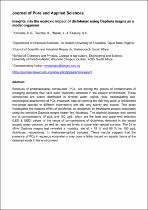 ResearchSpace
ResearchSpace
Insights into the ecotoxic impact of diclofenac using Daphnia magna as a model organism
JavaScript is disabled for your browser. Some features of this site may not work without it.
- ResearchSpace
- →
- Research Publications/Outputs
- →
- Journal Articles
- →
- View Item
| dc.contributor.author |
Omotola, EO

|
|
| dc.contributor.author |
Genthe, Bettina

|
|
| dc.contributor.author |
Ndlela, Luyanda L

|
|
| dc.contributor.author |
Olatunji, SO

|
|
| dc.date.accessioned | 2023-08-31T09:32:08Z | |
| dc.date.available | 2023-08-31T09:32:08Z | |
| dc.date.issued | 2023-06 | |
| dc.identifier.citation | Omotola, E., Genthe, B., Ndlela, L.L. & Olatunji, S. 2023. Insights into the ecotoxic impact of diclofenac using Daphnia magna as a model organism. <i>TASUED Journal of Pure and Applied Sciences, 2(1).</i> http://hdl.handle.net/10204/13022 | en_ZA |
| dc.identifier.issn | 1115-4195 | |
| dc.identifier.uri | http://hdl.handle.net/10204/13022 | |
| dc.description.abstract | Residues of pharmaceutical compounds (PCs) are among the groups of contaminants of emerging concerns that have been reportedly detected in the aquatic environment. These compounds are widely distributed in diverse water bodies, thus, necessitating eco-toxicological assessment of PCs. However, data concerning the risk they pose to unintended non-target species in different ecosystems are still very scanty and scarce. This study investigated the ecotoxic effect of diclofenac, an analgesic, on freshwater aquatic ecosystem using the sensitive Daphnia magna (water flea) bioassay. The daphnid bioassay was carried out at concentrations 10 µg/L and 100 µg/L, which are the least and upper-end detection (LED & UED) values of the range of concentrations of diclofenac detected in the tested aquatic water columns, as well as reported levels in some international surveys. The 24 to 48-hr Daphnia magna test revealed a mortality rate of > 75 % and 90 % for 100 µg/L diclofenac, respectively, in freshwater-spiked samples. These results suggest that the presence of PCs in aqueous ecosystems may pose a lethal impact on aquatic fauna at the detected levels in the environment. | en_US |
| dc.format | Abstract | en_US |
| dc.language.iso | en | en_US |
| dc.relation.uri | https://journals.tasued.edu.ng/index.php/tjopas/article/view/3 | en_US |
| dc.source | TASUED Journal of Pure and Applied Sciences, 2(1) | en_US |
| dc.subject | Bioassays | en_US |
| dc.subject | Daphnia magna | en_US |
| dc.subject | Emerging contaminants | en_US |
| dc.subject | Fauna | en_US |
| dc.subject | Mortality rate | en_US |
| dc.title | Insights into the ecotoxic impact of diclofenac using Daphnia magna as a model organism | en_US |
| dc.type | Article | en_US |
| dc.description.pages | 19-26 | en_US |
| dc.description.note | Copyright ©2023 All right reserved | TJOPAS. Due to copyright restrictions, the attached PDF file only contains the abstract of the full text item. For access to the full text item, please consult the publisher's website: https://journals.tasued.edu.ng/index.php/tjopas/article/view/3 | en_US |
| dc.description.cluster | Smart Places | en_US |
| dc.description.impactarea | Smart Water Analysis and Solutions | en_US |
| dc.identifier.apacitation | Omotola, E., Genthe, B., Ndlela, L. L., & Olatunji, S. (2023). Insights into the ecotoxic impact of diclofenac using Daphnia magna as a model organism. <i>TASUED Journal of Pure and Applied Sciences, 2(1)</i>, http://hdl.handle.net/10204/13022 | en_ZA |
| dc.identifier.chicagocitation | Omotola, EO, Bettina Genthe, Luyanda L Ndlela, and SO Olatunji "Insights into the ecotoxic impact of diclofenac using Daphnia magna as a model organism." <i>TASUED Journal of Pure and Applied Sciences, 2(1)</i> (2023) http://hdl.handle.net/10204/13022 | en_ZA |
| dc.identifier.vancouvercitation | Omotola E, Genthe B, Ndlela LL, Olatunji S. Insights into the ecotoxic impact of diclofenac using Daphnia magna as a model organism. TASUED Journal of Pure and Applied Sciences, 2(1). 2023; http://hdl.handle.net/10204/13022. | en_ZA |
| dc.identifier.ris | TY - Article AU - Omotola, EO AU - Genthe, Bettina AU - Ndlela, Luyanda L AU - Olatunji, SO AB - Residues of pharmaceutical compounds (PCs) are among the groups of contaminants of emerging concerns that have been reportedly detected in the aquatic environment. These compounds are widely distributed in diverse water bodies, thus, necessitating eco-toxicological assessment of PCs. However, data concerning the risk they pose to unintended non-target species in different ecosystems are still very scanty and scarce. This study investigated the ecotoxic effect of diclofenac, an analgesic, on freshwater aquatic ecosystem using the sensitive Daphnia magna (water flea) bioassay. The daphnid bioassay was carried out at concentrations 10 µg/L and 100 µg/L, which are the least and upper-end detection (LED & UED) values of the range of concentrations of diclofenac detected in the tested aquatic water columns, as well as reported levels in some international surveys. The 24 to 48-hr Daphnia magna test revealed a mortality rate of > 75 % and 90 % for 100 µg/L diclofenac, respectively, in freshwater-spiked samples. These results suggest that the presence of PCs in aqueous ecosystems may pose a lethal impact on aquatic fauna at the detected levels in the environment. DA - 2023-06 DB - ResearchSpace DP - CSIR J1 - TASUED Journal of Pure and Applied Sciences, 2(1) KW - Bioassays KW - Daphnia magna KW - Emerging contaminants KW - Fauna KW - Mortality rate LK - https://researchspace.csir.co.za PY - 2023 SM - 1115-4195 T1 - Insights into the ecotoxic impact of diclofenac using Daphnia magna as a model organism TI - Insights into the ecotoxic impact of diclofenac using Daphnia magna as a model organism UR - http://hdl.handle.net/10204/13022 ER - | en_ZA |
| dc.identifier.worklist | 26973 | en_US |





